Multiple Pregnancy and Birth: Twins, Triplets, and High-order Multiples
Revised 2012
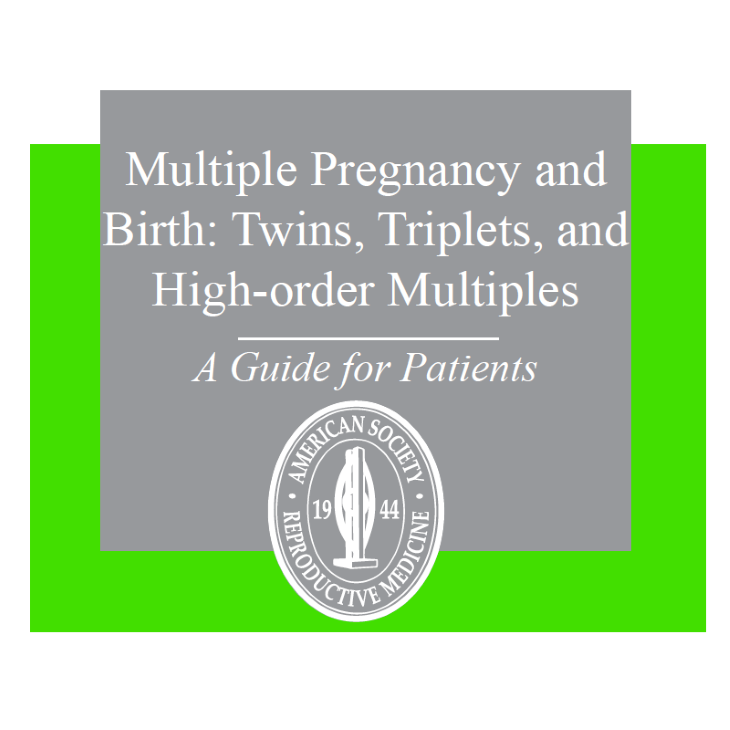 INTRODUCTION
INTRODUCTION
Multiple births are much more common today than they were in the past. According to the US Department of Health and Human Services, the twin birth rate has increased by over 75% since 1980, and triplet, quadruplet, and high-order multiple births have increased at an even higher rate. There are more multiple births today in part because more women are receiving infertility treatment, which carries a risk of multiple pregnancy. However, since the first publication in 1998 of the American Society for Reproductive Medicine’s (ASRM’s) Guidelines on Number of Embryos Transferred, the number of treatment-related pregnancies with triplets or more has decreased dramatically. Also, more women are waiting until later in life to attempt pregnancy, and older women are more likely than younger women to get pregnant with multiples, especially with fertility treatment. Although major medical advances have improved the outcomes of multiple births, multiple births still are associated with significant medical risks and complications for the mother and children. If you are at risk for a multiple pregnancy, this booklet will help you learn how and why multiple pregnancies occur and the unique issues associated with carrying and delivering a multiple pregnancy.TWINS--THE MOST COMMON MULTIPLE
You may know someone who has twins, but do you know how twins occur and how they develop? There are two types of twins: identical and fraternal (non-identical).Identical twins occur when a single embryo, created by the union of a sperm and an egg, divides into two embryos. Each embryo is monozygotic, genetically identical, and both will be the same sex. Depending on when the division occurs, identical twins may have separate placentas and gestational sacs, or they may share a single placenta but have separate sacs. In rare cases, identical twins may be in the same amniotic sac.
Non-identical twins occur when two separate eggs are each fertilized by a separate sperm. The two embryos that result are dizygotic, not genetically identical, and can be the same or different sex. Most of the time, this is the type of twinning that occurs from assisted reproduction procedures.
Figure 1
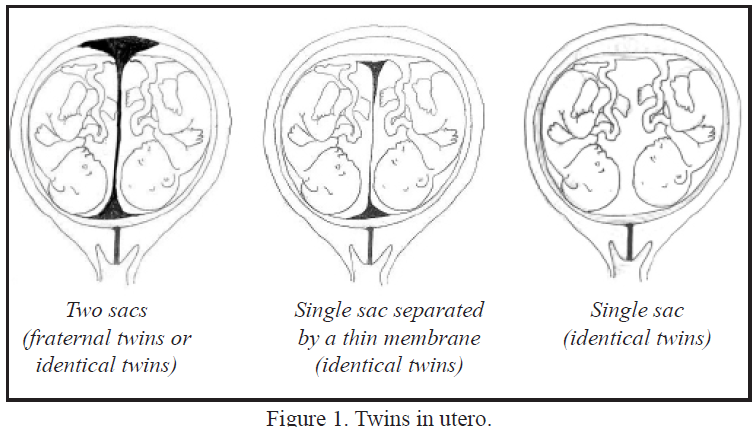
The “Vanishing Twin Syndrome”
Sometimes, very early in a twin pregnancy, one of the fetuses “disappears.” This is referred to as the “vanishing twin syndrome.” Even after ultrasound has shown heart movement in twins, spontaneous loss of one of the fetuses occurs in up to 20% of twin pregnancies. Spontaneous losses are even higher in triplet and quadruplet pregnancies. A fetal loss rate of 40% may occur in pregnancies with triplets or more. When a fetus is lost in the first trimester, the remaining fetus or fetuses generally continue to develop normally, although vaginal bleeding may occur.Ultrasound examinations performed early in the 5th week of pregnancy occasionally may fail to identify all fetuses. An “appearing twin” may be found after the 5th week in nearly 10% of non-identical twin or multiple pregnancies and in over 80% of cases of identical twins. After 6 to 8 weeks, ultrasound should provide an accurate assessment of the number of fetuses.
Risk Factors for Multiple Pregnancy
Naturally, twins occur in about one in 250 pregnancies, triplets in about one in 10,000 pregnancies, and quadruplets in about one in 700,000 pregnancies. The main factor that increases your chances of having a multiple pregnancy is the use of infertility treatment, but there are other factors.Your race, age, heredity, or history of prior pregnancy does not increase your chance of having identical twins but does increase your chance of having fraternal twins. Infertility treatment increases your risk of having twins, both identical and fraternal.
Race. The overall rate of twins for all races in the United Statees is around 33 per 1,000 live births. Black and non-Hispanic white women have similar rates of twinning, while Hispanic women are less likely.
Heredity. The mother’s family history may be more significant than the father’s. Non-identical twin women give birth to twins at the rate of 1 set per 60 births. However, non-identical male twins father twins at a rate of 1 set per 125 births.
Maternal age and prior pregnancy history. The frequency of twins increases with maternal age and number of pregnancies. Women between 35 to 40 years of age with 4 or more children are 3 times more likely to have twins than a woman under 20 without children.
Maternal height and weight. Non-identical twins are more common in large and tall women than in small women. This may be related more to nutrition than to body size alone. During World War II, the incidence of non-identical twinning decreased in Europe when food was not readily available.
Fertility Drugs and Assisted Reproductive Technology. Multiple pregnancy is more common in women who utilize fertility medications to undergo ovulation induction or superovulation. Of women who achieve pregnancy with clomiphene citrate, approximately 5% to 12% bear twins, and less than 1% bear triplets or more. Use of drugs to cause superovulation has caused the vast majority of the increase in the multiples.
Approximately 30% of pregnancies resulting from gonadotropins are multiples. While most of these pregnancies are twins, up to 5% are triplets or greater due to the release of more eggs than expected.
Assisted reproductive technology (ART) procedures such as in vitro fertilization (IVF) also contribute to the increase in the multiple birth rate. The risk of multiple pregnancy increases as the number of embryos transferred increases.
DURATION OF MULTIPLE PREGNANCIES
The duration of a normal singleton pregnancy ranges from 37 weeks to 42 weeks from the time of the last menstrual period. Twin pregnancies occasionally progress to 40 weeks but almost always deliver early. As the number of fetuses increases, the expected duration of the pregnancy decreases. The average duration is 35 weeks for twins, 33 weeks for triplets, and 30 weeks for quadruplets.| TYPE OF PREGNANCY | AVERAGE GESTATIONAL AGE AT TIME OF DELIVERY | AVERAGE BIRTH WEIGHT |
| Singleton | 38.6 weeks | 7.3 lb. (3,300 grams) |
| Twin | 35 weeks | 5.1 lb. (2,300 grams) |
| Triplet | 32 weeks | 3.7 lb. (1,660 grams) |
| Quadruplet | 30 weeks | 2.9 lb. (1,300 grams) |
COMPLICATIONS OF MULTIPLE PREGNANCIES
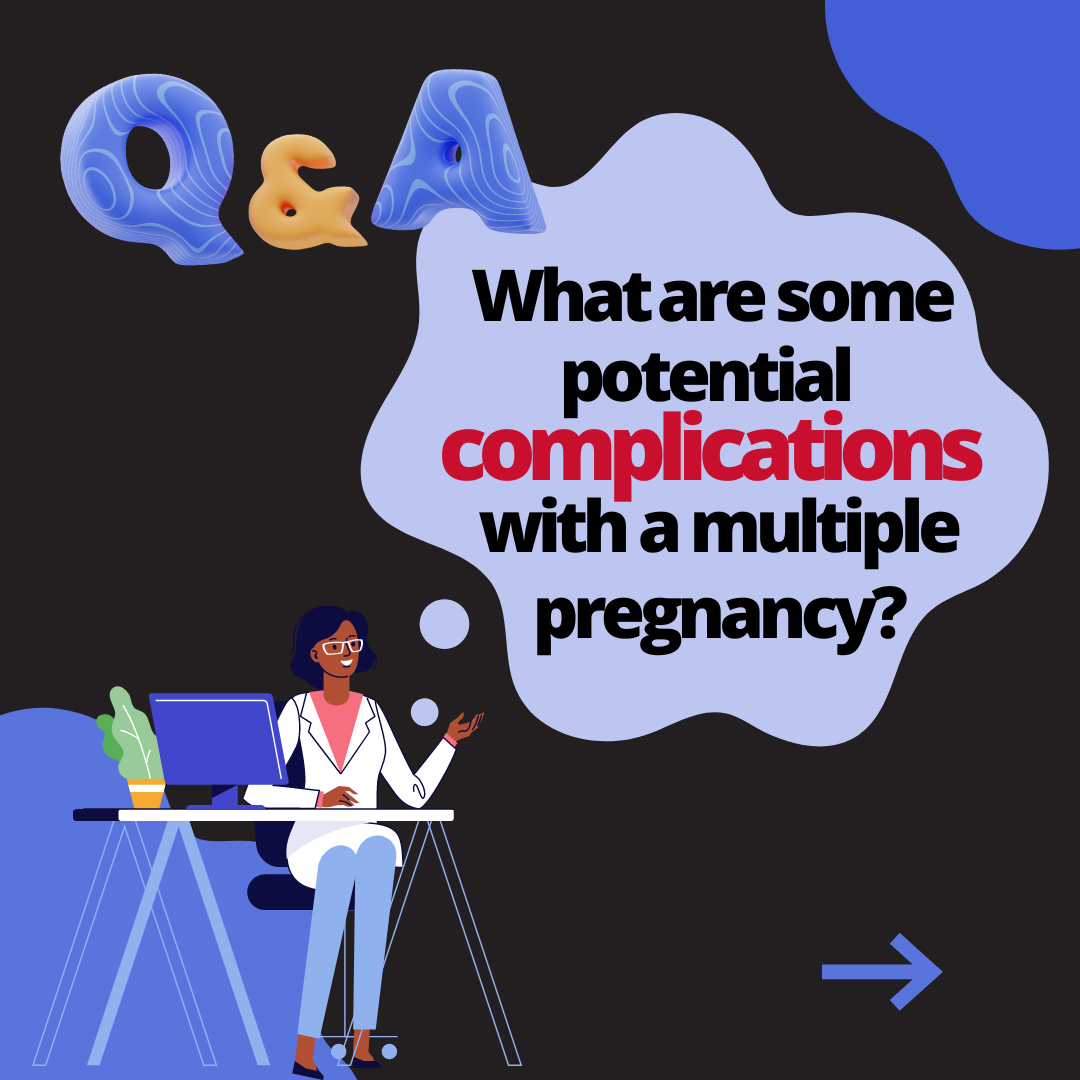 Complications increase with each additional fetus in a multiple pregnancy and include many medical issues that will be discussed below. In addition to these, there is a higher incidence of severe nausea and vomiting, cesarean section, or forceps delivery. If you are pregnant with twins or more, or if you are at risk for a multiple pregnancy, you should be aware of these and other potential problems you might experience.
Complications increase with each additional fetus in a multiple pregnancy and include many medical issues that will be discussed below. In addition to these, there is a higher incidence of severe nausea and vomiting, cesarean section, or forceps delivery. If you are pregnant with twins or more, or if you are at risk for a multiple pregnancy, you should be aware of these and other potential problems you might experience.Preterm Birth
Preterm labor and birth pose the greatest risk to a multiple pregnancy. Sixty percent of multiples are born prematurely (<37 weeks) compared to about 10% of singleton pregnancies. Feasibility of a vaginal delivery depends on the size, position, and health of the infants, as well as the size and shape of the mother’s pelvic bones. Cesarean section is often needed for twin pregnancies and is expected for delivery of triplets.Since preterm labor and birth present such serious risks, the pregnant mother must understand the warning signs of early labor. Pelvic pressure, low back pain, increased vaginal discharge, or a change in the frequency of “false labor” pains should be reported to the physician. Sometimes, preterm delivery can be delayed by a few days or more if it is detected early. Each day gained provides valuable fetal growth and development. Once a woman is in advanced labor, delivery cannot be stopped. In rare instances, delivery of a second twin can be delayed. This delay, when possible, allows for continued growth in the protective environment of the uterus. Currently, there are no effective treatments to prevent preterm birth of multiples.
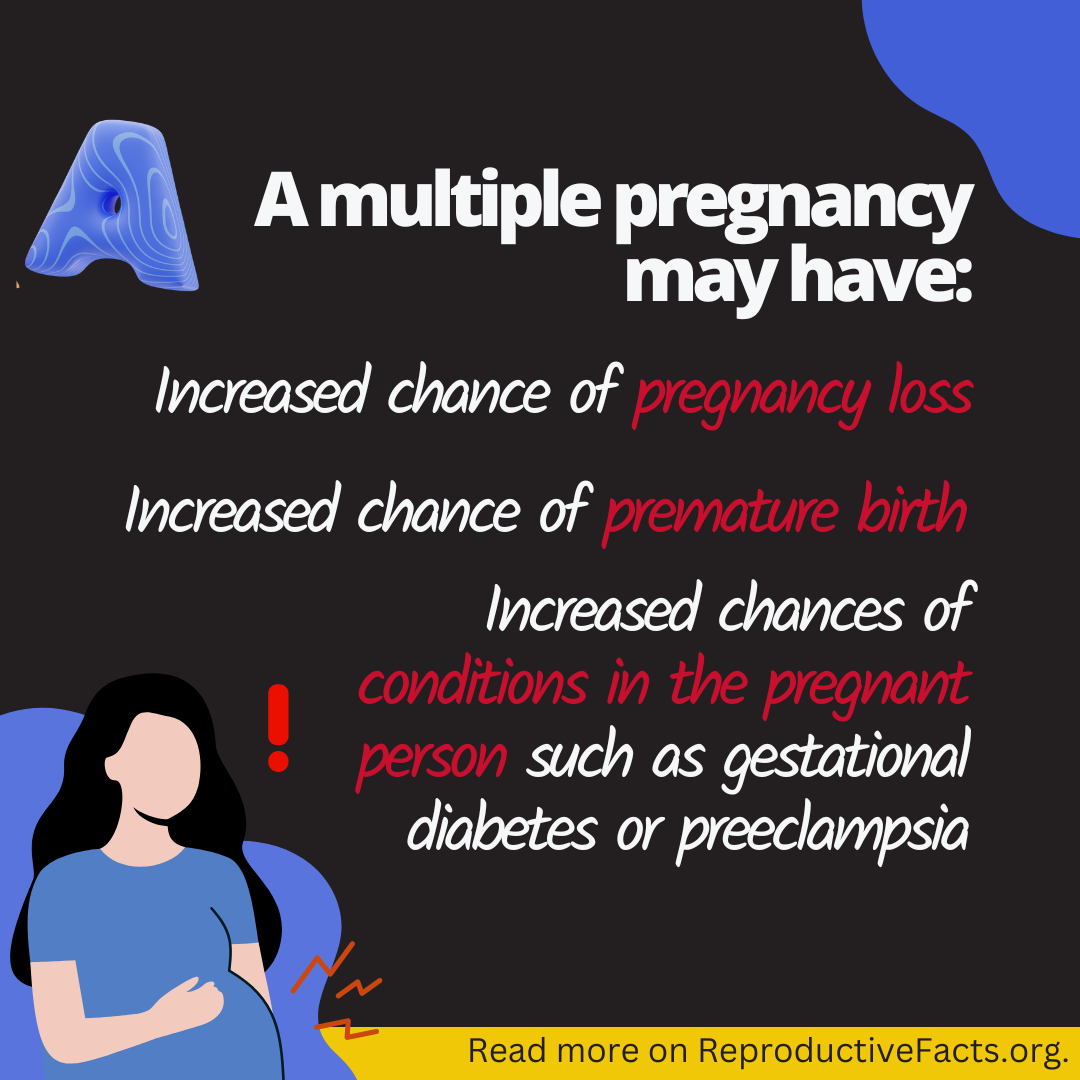
Placental Problems
The placenta is attached to the wall of the uterus, and the fetus is attached to the placenta by the umbilical cord. The placenta provides blood, oxygen, and nutrition to the fetus through the umbilical cord. Placental function is more likely to be abnormal in a multiple pregnancy. If the placenta is unable to provide adequate oxygen or nutrients to the fetus, the fetus cannot grow properly. The placenta ages prematurely and may slow fetal growth, especially late in the third trimester. Twins and high-order multiples that are more than 30% “underweight” by ultrasound measurements are at increased risk of complications and have death rates of nearly 25%.Another placental problem is twin-twin transfusion, a life-threatening condition in identical twins. This transfusion occurs when blood flows from one fetus to the other through a connection in a shared placenta. Poor growth occurs in the “donor” twin, and excessive fluid develops in the “recipient” twin. Therapeutic amniocentesis and laser coagulation of blood vessels that link circulation to the twins in the placenta(s) may reduce complications of twin-twin transfusion.
Preeclampsia
Preeclampsia, also known as toxemia, occurs 2 to 5 times more often in multiple pregnancies. Fifteen percent to 20% of women with twin pregnancies will experience preeclampsia, and an even higher percentage is preeclamptic in triplet or high-order pregnancies. Preeclampsia is diagnosed when the mother’s blood pressure becomes elevated and protein is detected in the urine. The condition may progress and threaten the health of the mother and baby. When severe, the mother may have seizures, and stroke or other life-threatening complications are possible.Diabetes
Women with multiple pregnancies are more likely to develop gestational diabetes during pregnancy. Babies of diabetic mothers are more likely to experience respiratory distress and other newborn complications. However, gestational diabetes is common even in singleton pregnancies, and treatment is well established and effective.Fetal and Newborn Complications
Although uncommon in twin deliveries, about 20% of triplet pregnancies will result in the delivery of at least one child with a major long-term handicap. Preterm delivery places an infant at increased risk for severe complications or early death. A baby’s lungs, brain, circulatory system, intestinal system, and eyes may be not fully developed.Of the premature babies who die, 50% succumb to respiratory distress syndrome, caused by immature lungs. Brain damage is responsible for almost 10% of premature newborn deaths. Prematurity also may result in visual impairment or blindness. Birth defects and stillbirths account for about 30% of the deaths in twins and multiple pregnancies. Neonatal intensive care unit admission is required for one-fourth of twin and three-fourths of triplet deliveries.
Despite these numbers, it is important to note that the vast majority of multiple-birth infants do survive. Fetal death occurs in about 1.6% of twins and 2.7% of triplets. Furthermore, compared to singleton pregnancies of the same birth weight, there is no significant increase in the incidence of chronic lung disease or brain, eye, or gastrointestinal problems in multiple-birth infants.
Low birth weight of less than 5.5 pounds (lb.) [2,500 grams] occurs in over half of twins. The average birth weight is approximately 4 lb. (1,660 grams) for triplets and 3 lb. (1,300 grams) for quadruplets. As a result of prematurity, the risk for cerebral palsy is 4 times more likely to occur in twins. The rates are even greater for triplets and high-order multiple births. The overall survival rate is 85% for newborns over 2 lb., 3 oz. (1,000 grams) but less than 40% for those under 2 lb., 3 oz. Birth weight also corresponds closely to the severity of disability throughout the childhood years. Disability occurs in almost 25% of children with a birth weight less than 2 lb. As noted above, the average birth weight even for quadruplets is well above this number.
PREVENTION OF MULTIPLE PREGNANCY
Prevention during infertility treatment is the best approach to avoiding a multiple pregnancy. In ART cycles, limiting the number of embryos transferred is an effective approach. Consult the ASRM Practice Committee Report titled Guidelines on Number of Embryos Transferred for recommendations regarding the optimal number of embryos to transfer based on patient age, embryo quality, and other criteria.In the United States, physicians and patients jointly decide how many embryos to transfer. However, in England, no more than two embryos may be transferred in most cases. In Canada, a maximum of three embryos are recommended for transfer.
The ultimate goal of ART is to achieve a high pregnancy rate while transferring a single embryo. While physicians can transfer two embryos and still maintain acceptable pregnancy rates, the transfer of one embryo is associated with good pregnancy rates in certain patient groups, thereby resolving the problem of multiple pregnancies caused by multiple embryo transfer. Approximately 10% of embryo transfers in the United States are now performed using elective single embryo transfer.
Multiple pregnancies are a known complication of ovulation stimulation drugs. Most physicians monitor patients with ultrasound examinations and blood tests. A woman with a large number of ovarian follicles or high hormone levels has an increased risk of a multiple pregnancy, and the cycle may be canceled to avoid the risk. No proven way of reducing multiple pregnancies with superovulation has been identified, although preventing fertilization with development of more than three follicles is helpful in reducing high-order multiples.
Multifetal Pregnancy Reduction
When a triplet or high-order multiple pregnancy occurs, multifetal pregnancy reduction may be considered to improve the chance for survival of the fetuses. While multifetal pregnancy reduction carries some risk of a complete miscarriage, it also reduces the chances of extreme premature birth. For more information, see the ASRM Patient Fact Sheet Challenges of Parenting Multiples.CARRYING A MULTIPLE PREGNANCY
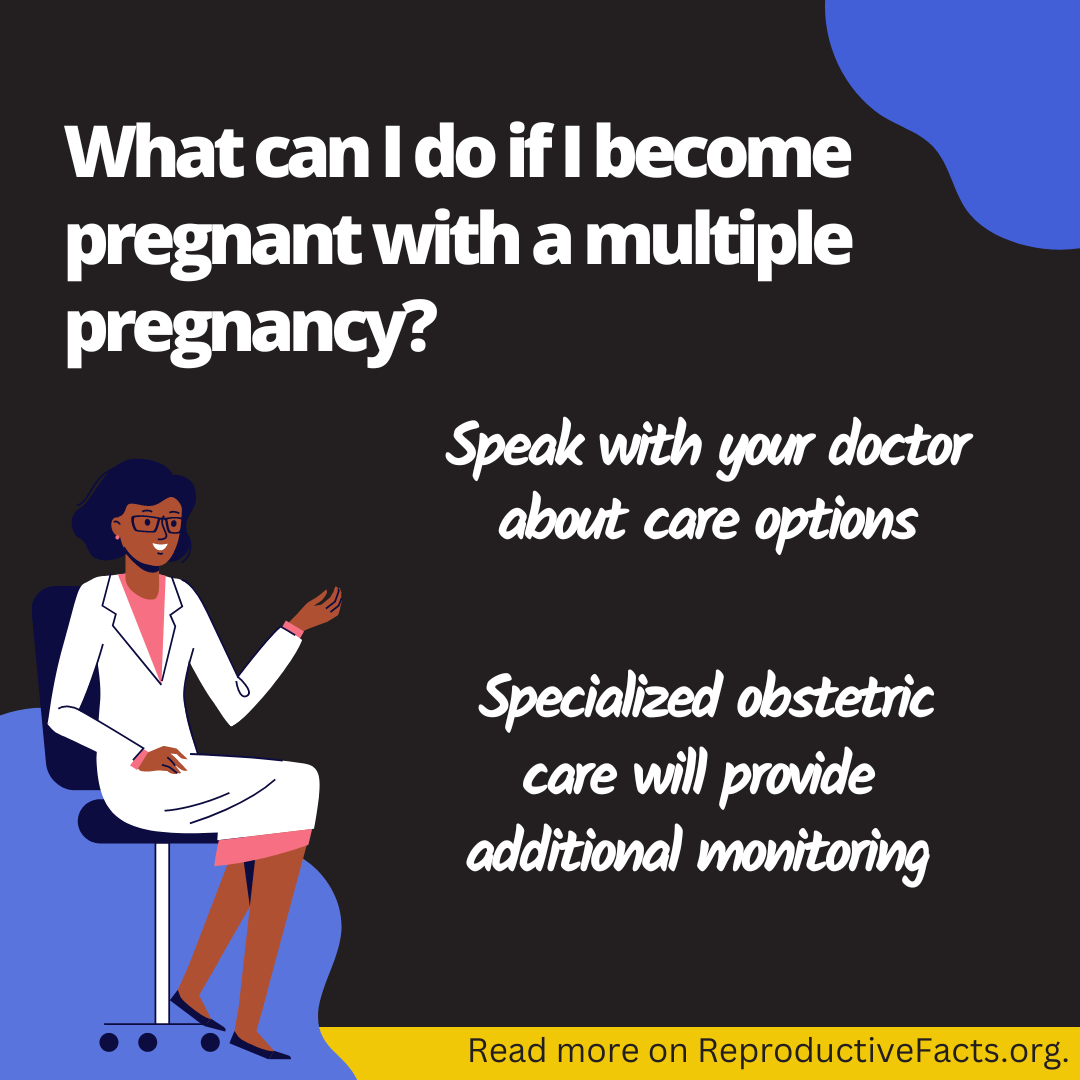 In order to achieve the best outcome with a multiple pregnancy, the expectant mother must work as part of the health care team. A nearly total change in lifestyle can be expected, especially after about 20 weeks into the pregnancy.
In order to achieve the best outcome with a multiple pregnancy, the expectant mother must work as part of the health care team. A nearly total change in lifestyle can be expected, especially after about 20 weeks into the pregnancy.Metabolic and Nutritional Considerations
There is an increased need for maternal nutrition in multiple pregnancies. An expectant mother needs to gain more weight in a multiple pregnancy, especially if she begins the pregnancy underweight. With multiples, weight gain of approximately 37-54 lb. is recommended for normal-weight women. The pattern of weight gain is important too. Healthy birth weights are most likely achieved when the mother gains nearly one pound per week in the first 20 weeks. The increase in fetal growth with appropriate nutrition and weight gain may greatly improve pregnancy outcome at a minimum of cost.Activity Precautions
Many physicians who manage multiple pregnancies believe that a reduction in activities and increased rest prolongs these pregnancies and improves outcomes. However, routine hospitalization for bed rest in multiple pregnancy has not been shown to prevent preterm birth. Women with high-order multiple pregnancies usually are advised to avoid strenuous activity and employment at some time between 20 and 24 weeks. Bed rest improves uterine blood flow and may be helpful for fetal growth problems. Intercourse generally is discouraged when bed rest is recommended.Monitoring a Multiple Pregnancy
Since preterm birth and growth disturbances are the major contributors to newborn death and disability in multiples, frequent obstetric visits and close monitoring of the pregnancy are needed.Prenatal diagnosis using a variety of new techniques can be done near the end of the first trimester to screen for Down syndrome and other genetic abnormalities. Amniocentesis may be performed between 16 and 20 weeks. Amniocentesis may be complicated and difficult to perform in twins and triplets and may not be possible in high-order multiple pregnancies. However, reasonable data exist for the use of serum screening in the setting of multiple pregnancies and can be a helpful tool to assess risk of these and other conditions.
Many physicians perform cervical examinations every week or two beginning early in pregnancy to determine if the cervix is thinning or opening prematurely. If an exam or ultrasound shows that the cervix is thinning or beginning to dilate prematurely, a cerclage, or suture placed in the cervix, may prevent or delay premature dilatation. However, preventative cerclage has not been shown to prevent preterm birth in twins or triplets.
Tocolytic agents are medications that may slow or stop premature labor. These medications are given in hospital “emergency” settings in an attempt to stop premature labor. It is important to attempt to delay delivery to minimize the risks of premature delivery. Ultrasound examinations in the second trimester can identify some birth defects. Assessment of fetal growth by ultrasound every 3 to 4 weeks during the second half of pregnancy is commonly performed.
Every multiple pregnancy should be considered at high risk, and obstetricians experienced with the management of multiple gestations should provide care. A neonatal intensive care unit nursery should be available to provide immediate and comprehensive support to premature newborns.
Method of Delivery
Vaginal delivery of twins may be safe in some circumstances. Many twins can be delivered vaginally if the lowest infant is in the head-first position. Most triplets will be delivered by cesarean section. Appropriate anesthesia and neonatal support are essential, whether delivery is performed vaginally or requires cesarean section. Delivery of multiples requires planning by the entire medical team and availability of full intensive-care support following birth.Psychosocial Effects of Multiples on a Family
Although the majority of women with a multiple pregnancy do very well, their families may experience significant stress. If prolonged hospitalization is needed, arrangements must be made for work, home, and family care.Even when medical problems are overcome and the infants survive without disability, the effect of multiple births on family life is substantial. The impact of a multiple birth clearly affects the parents, but also the babies, other siblings, and the extended family. Financial stresses are common, due to the additional costs of feeding, clothing, housing, and caring for multiple children. Postpartum depression also is more common after delivery of multiple pregnancies in both the mother and the father and may be long-term.
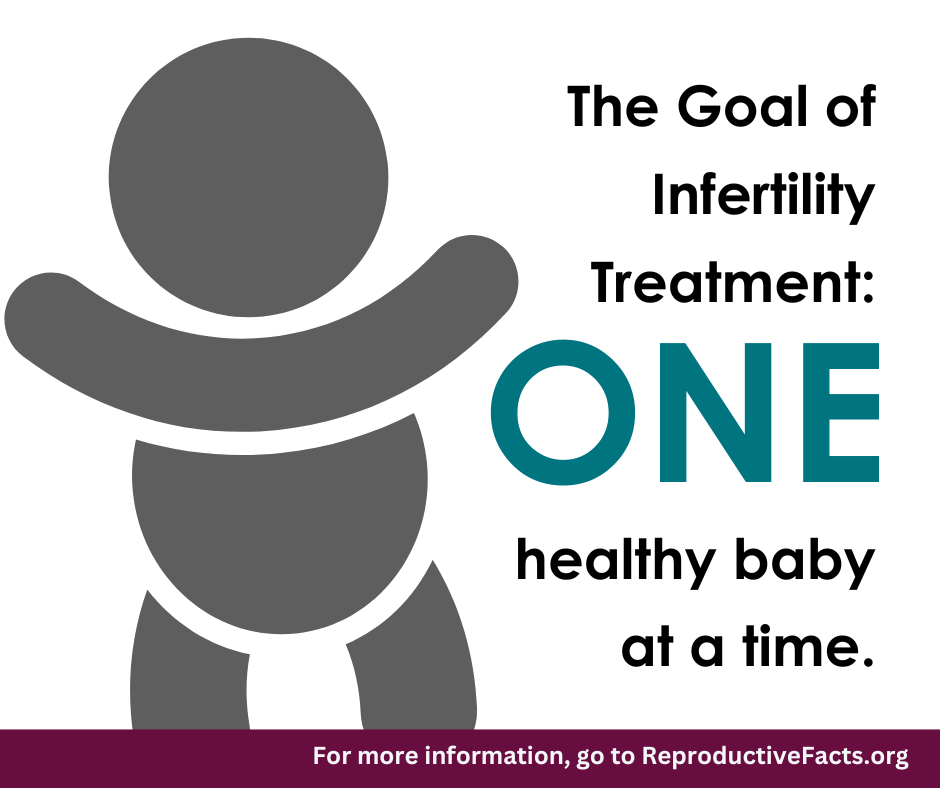 Psychological counseling and support groups may provide a lifeline for the parents of multiples, who may feel isolated or depressed. Most physicians can provide appropriate referrals to a mental health professional or a support group. For more information, see the ASRM Patient Fact Sheet titled Challenges of Parenting Multiples.
Psychological counseling and support groups may provide a lifeline for the parents of multiples, who may feel isolated or depressed. Most physicians can provide appropriate referrals to a mental health professional or a support group. For more information, see the ASRM Patient Fact Sheet titled Challenges of Parenting Multiples.CONCLUSION
The objective of infertility treatment is the birth of a healthy child. In a small percentage of patients, treatment results in multiple pregnancy that may place the mother and the babies at increased risk for an unhealthy outcome. Since multiple pregnancies and their complications are an inevitable risk of fertility therapies, education about these risks is crucial prior to treatment. Ultimately, prevention is the key to reducing the risk of multiple pregnancy.Glossary
American Society for Reproductive Medicine (ASRM). A professional medical organization of approximately 9,000 health care specialists interested in reproductive medicine.
Amniocentesis. A procedure in which a small amount of amniotic fluid is removed through a needle from the fetal sac at about 16 weeks into a pregnancy. The fluid is studied for chromosomal abnormalities that may affect fetal development.
Amnion. Thin membrane that expands to enclose a developing fetus. This membrane (sac) holds the amniotic fluid that protects the developing fetus.
Assisted reproductive technology (ART). All treatments that include laboratory handling of eggs, sperm, and/or embryos. Some examples of ART are in vitro fertilization (IVF), gamete intrafallopian transfer (GIFT), pronuclear stage tubal transfer (PROST), tubal embryo transfer (TET), and zygote intrafallopian transfer (ZIFT).
Cerclage. Placement of a nonabsorbable suture around an incompetent (weak) cervical opening in an attempt to keep it closed and thus prevent miscarriage. Also known as a cervical stitch.
Cerebral palsy. A disorder causing damage to one or more specific areas of the brain usually occurring during fetal development; before, during, or shortly after birth; or in infancy. Cerebral palsy is characterized by an inability to fully control motor function, particularly muscle control and coordination. Other problems that may arise are difficulties in feeding, bladder and bowel control, problems with breathing, skin disorders, and learning disabilities.
Cervix. The lower, narrow end of the uterus that connects the uterine cavity to the vagina.
Clomiphene citrate. An oral anti-estrogen drug used to induce ovulation in the female.
Diabetes. A condition due to abnormal production of insulin resulting in abnormally elevated blood glucose (sugar) levels.
Dizygotic. Di - two; zygote - fertilized egg. Two separate eggs fertilized by separate sperm in a single pregnancy. Fraternal twins.
Egg. The female sex cell produced by the ovaries, which, when fertilized by a male’s sperm, produce embryos.
Embryo. The earliest stage of human development arising after the union of the sperm and egg (fertilization).
Fetus. An unborn child.
Follicle (ovarian). A fluid-filled sac located just beneath the surface of the ovary containing an egg (oocyte) and cells that produce hormones. The sac increases in size and volume during the first half of the menstrual cycle and at ovulation the follicle matures and ruptures, releasing the egg. As the follicle matures, it can be visualized by ultrasound.
Genetic. Referring to inherited conditions, usually due to the genes located on the chromosomes.
Gestation. Pregnancy.
Gestational diabetes. Elevated blood sugar levels in the mother while she is pregnant. During pregnancy, the placenta normally produces hormones that antagonize insulin. With a multiple pregnancy, more of these hormones are produced and lead to a rise in the mother’s blood sugar.
Gestational sac (amniotic sac). The fluid-filled sac surrounding an embryo that develops within the uterine cavity. Ultrasound can detect the sac in the uterus at a very early stage of pregnancy.
Gonadotropins. Follicle-stimulating hormone (FSH) and luteinizing hormone (LH). FSH and LH may be purified or synthetically produced to be used as ovulatory drugs.
Hormone. Substances secreted from organs of the body, such as the pituitary gland, adrenal gland, or ovaries, which are carried by a bodily fluid such as blood to other organs or tissues where the substances exert a specific action.
Amniocentesis. A procedure in which a small amount of amniotic fluid is removed through a needle from the fetal sac at about 16 weeks into a pregnancy. The fluid is studied for chromosomal abnormalities that may affect fetal development.
Amnion. Thin membrane that expands to enclose a developing fetus. This membrane (sac) holds the amniotic fluid that protects the developing fetus.
Assisted reproductive technology (ART). All treatments that include laboratory handling of eggs, sperm, and/or embryos. Some examples of ART are in vitro fertilization (IVF), gamete intrafallopian transfer (GIFT), pronuclear stage tubal transfer (PROST), tubal embryo transfer (TET), and zygote intrafallopian transfer (ZIFT).
Cerclage. Placement of a nonabsorbable suture around an incompetent (weak) cervical opening in an attempt to keep it closed and thus prevent miscarriage. Also known as a cervical stitch.
Cerebral palsy. A disorder causing damage to one or more specific areas of the brain usually occurring during fetal development; before, during, or shortly after birth; or in infancy. Cerebral palsy is characterized by an inability to fully control motor function, particularly muscle control and coordination. Other problems that may arise are difficulties in feeding, bladder and bowel control, problems with breathing, skin disorders, and learning disabilities.
Cervix. The lower, narrow end of the uterus that connects the uterine cavity to the vagina.
Clomiphene citrate. An oral anti-estrogen drug used to induce ovulation in the female.
Diabetes. A condition due to abnormal production of insulin resulting in abnormally elevated blood glucose (sugar) levels.
Dizygotic. Di - two; zygote - fertilized egg. Two separate eggs fertilized by separate sperm in a single pregnancy. Fraternal twins.
Egg. The female sex cell produced by the ovaries, which, when fertilized by a male’s sperm, produce embryos.
Embryo. The earliest stage of human development arising after the union of the sperm and egg (fertilization).
Fetus. An unborn child.
Follicle (ovarian). A fluid-filled sac located just beneath the surface of the ovary containing an egg (oocyte) and cells that produce hormones. The sac increases in size and volume during the first half of the menstrual cycle and at ovulation the follicle matures and ruptures, releasing the egg. As the follicle matures, it can be visualized by ultrasound.
Genetic. Referring to inherited conditions, usually due to the genes located on the chromosomes.
Gestation. Pregnancy.
Gestational diabetes. Elevated blood sugar levels in the mother while she is pregnant. During pregnancy, the placenta normally produces hormones that antagonize insulin. With a multiple pregnancy, more of these hormones are produced and lead to a rise in the mother’s blood sugar.
Gestational sac (amniotic sac). The fluid-filled sac surrounding an embryo that develops within the uterine cavity. Ultrasound can detect the sac in the uterus at a very early stage of pregnancy.
Gonadotropins. Follicle-stimulating hormone (FSH) and luteinizing hormone (LH). FSH and LH may be purified or synthetically produced to be used as ovulatory drugs.
Hormone. Substances secreted from organs of the body, such as the pituitary gland, adrenal gland, or ovaries, which are carried by a bodily fluid such as blood to other organs or tissues where the substances exert a specific action.
Infertility. Infertility is the result of a disease of the male or female reproductive tract that prevents the conception of a child or the ability to carry a pregnancy to delivery. The duration of unprotected intercourse with failure to conceive should be about 12 months or more before an investigation is undertaken, unless medical history, age, and physical findings dictate earlier evaluation and treatment.
In vitro fertilization (IVF). A method of assisted reproduction that involves combining an egg with sperm in a laboratory dish. If the egg fertilizes and begins cell division, the resulting embryo is transferred into the woman’s uterus where it can implant in the uterine lining and further develop. IVF is generally performed in conjunction with medications that stimulate the ovaries to produce multiple eggs in order to increase the chances of successful fertilization and implantation. IVF bypasses the fallopian tubes and is often the treatment choice for women who have badly damaged or absent tubes.
Miscarriage. The naturally occurring expulsion of a nonviable fetus and placenta from the uterus; also known as spontaneous abortion or pregnancy loss.
Monozygotic. Mono - one; zygotic - fertilized egg. One egg fertilized by a single sperm that divides into two embryos. Identical twins.
Multifetal pregnancy reduction. Also known as selective reduction. A procedure to reduce the number of fetuses in the uterus. As the risk of miscarriage (spontaneous abortion) and other problems increases with the number of fetuses present, this procedure may be performed in an attempt to prevent the entire pregnancy from aborting or delivering very prematurely.
Ovulation induction. The administration of hormone medications (ovulation drugs) that stimulate the ovaries to develop a follicle and ovulate.
Placenta. A disk-shaped vascular organ attached to the wall of the uterus and to the fetus by the umbilical cord. It provides nourishment to the fetus and carries away waste.
Preeclampsia. A disorder occurring during pregnancy that affects both the mother and the fetus. Preeclampsia is characterized by high blood pressure, swelling, and protein found in the urine. This disorder, also know as toxemia, can restrict the flow of blood to the placenta.
Respiratory distress syndrome (RDS). A lung disease that affects premature infants and causes increasing difficulty in breathing.
Singleton. Offspring (child) born singly.
Sperm. The male reproductive cells that fertilize a woman’s egg. The sperm head carries genetic material (chromosomes); the midpiece produces energy for movement; and the long, thin tail wiggles to propel the sperm.
Superovulation. The administration of fertility medications in a manner intended to achieve development and ovulation of multiple ovarian follicles. Superovulation is often combined with intrauterine insemination as an infertility treatment.
Suture. Thread used to close an incision made during surgery. It generally is absorbable or self-dissolving.
Tocolytic agents. Medications that may slow or stop premature labor.
Toxemia. See Preeclampsia.
Ultrasound. Also called sonogram. A picture of internal organs produced by high frequency sound waves viewed as an image on a video screen; used to monitor growth of ovarian follicles, to retrieve eggs, and to monitor a fetus or pregnancy. Ultrasound examinations can be performed either abdominally or vaginally.
Uterus (womb). The hollow, muscular organ in the pelvis where an embryo implants and grows during pregnancy. The lining of the uterus, called the endometrium, produces the monthly menstrual blood flow when there is no pregnancy.
In vitro fertilization (IVF). A method of assisted reproduction that involves combining an egg with sperm in a laboratory dish. If the egg fertilizes and begins cell division, the resulting embryo is transferred into the woman’s uterus where it can implant in the uterine lining and further develop. IVF is generally performed in conjunction with medications that stimulate the ovaries to produce multiple eggs in order to increase the chances of successful fertilization and implantation. IVF bypasses the fallopian tubes and is often the treatment choice for women who have badly damaged or absent tubes.
Miscarriage. The naturally occurring expulsion of a nonviable fetus and placenta from the uterus; also known as spontaneous abortion or pregnancy loss.
Monozygotic. Mono - one; zygotic - fertilized egg. One egg fertilized by a single sperm that divides into two embryos. Identical twins.
Multifetal pregnancy reduction. Also known as selective reduction. A procedure to reduce the number of fetuses in the uterus. As the risk of miscarriage (spontaneous abortion) and other problems increases with the number of fetuses present, this procedure may be performed in an attempt to prevent the entire pregnancy from aborting or delivering very prematurely.
Ovulation induction. The administration of hormone medications (ovulation drugs) that stimulate the ovaries to develop a follicle and ovulate.
Placenta. A disk-shaped vascular organ attached to the wall of the uterus and to the fetus by the umbilical cord. It provides nourishment to the fetus and carries away waste.
Preeclampsia. A disorder occurring during pregnancy that affects both the mother and the fetus. Preeclampsia is characterized by high blood pressure, swelling, and protein found in the urine. This disorder, also know as toxemia, can restrict the flow of blood to the placenta.
Respiratory distress syndrome (RDS). A lung disease that affects premature infants and causes increasing difficulty in breathing.
Singleton. Offspring (child) born singly.
Sperm. The male reproductive cells that fertilize a woman’s egg. The sperm head carries genetic material (chromosomes); the midpiece produces energy for movement; and the long, thin tail wiggles to propel the sperm.
Superovulation. The administration of fertility medications in a manner intended to achieve development and ovulation of multiple ovarian follicles. Superovulation is often combined with intrauterine insemination as an infertility treatment.
Suture. Thread used to close an incision made during surgery. It generally is absorbable or self-dissolving.
Tocolytic agents. Medications that may slow or stop premature labor.
Toxemia. See Preeclampsia.
Ultrasound. Also called sonogram. A picture of internal organs produced by high frequency sound waves viewed as an image on a video screen; used to monitor growth of ovarian follicles, to retrieve eggs, and to monitor a fetus or pregnancy. Ultrasound examinations can be performed either abdominally or vaginally.
Uterus (womb). The hollow, muscular organ in the pelvis where an embryo implants and grows during pregnancy. The lining of the uterus, called the endometrium, produces the monthly menstrual blood flow when there is no pregnancy.
Fact Sheets/Booklets
View more fact sheets and booklets written by the ASRM Patient Education Committee.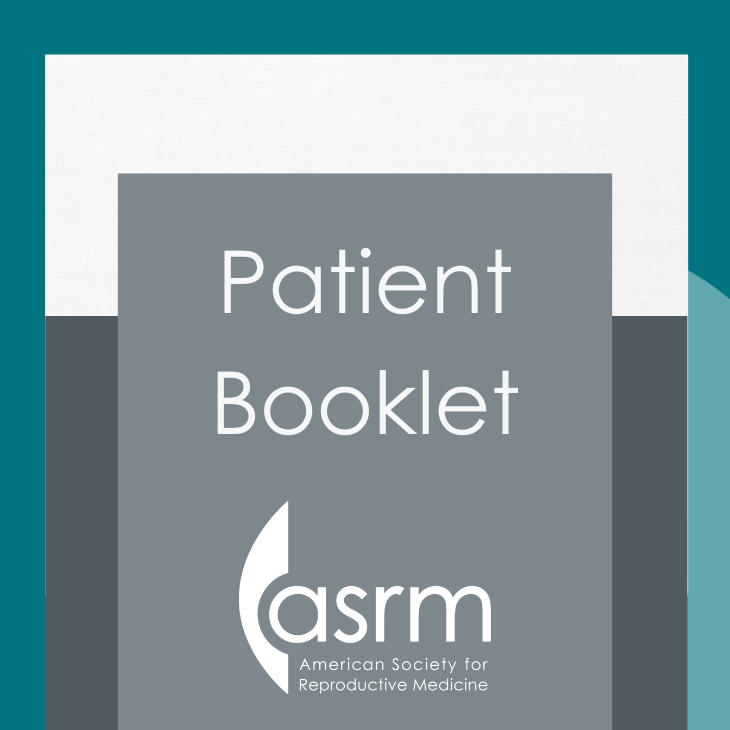
Assisted Reproductive Technologies (booklet)
This booklet will help you understand in vitro fertilization (IVF) and other assisted reproductive technology (ART) that have become accepted medical treatments for infertility.
Hormonal Contraception
Hormonal contraceptives contain a progestin (progesterone medicine) with or without an estrogen.
What do I need to know about Zika virus and trying to have a baby?
Common symptoms include fever, rash, joint pain, conjunctivitis (red eyes), muscle pain, and headache.
Third-Party Reproduction
The phrase “third-party reproduction” refers to involving someone other than the individual or couple that plans to raise the child (intended parent[s]) in the process of reproduction.In Vitro Fertilization (IVF)
Multiple Births or Multiple Gestation
Find a Health Professional
Connect with reproductive medicine experts who will guide you through your unique journey. Our search tool allows personalized matches based on location, specialization, and expertise. Take control of your reproductive health with compassionate providers, innovative treatments, and unwavering support.
Search for an Expert











